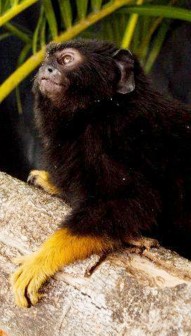The Golden-handed Tamarin (Saguinus midas), also known as Midas Tamarin and Red-handed Tamarin can be seen along farm edges in the North Rupununi, but interestingly enough does not exist in the Iwokrama Rain Forest. The species can also be found in Northern Brazil and the Guianas; sightings in Venezuela have not been confirmed. There is a subspecies found in Brazil, which does not have the distinctive golden hand and foot colour and this has been elevated to a species category of its own.
The Golden-handed Tamarin can be found in lowland, hilly forest, savannah forest and white sand forest with a preference to forest edge in trees with small crowns. These monkeys can also be found in secondary habitat close to human dwelling. They are small-bodied monkeys with black hair overall except for the hands, feet and mid to lower back which are speckled orangish red. The hands and feet can be orangy red to yellow in colour. Four of the toes on the feet have claws while the big toe carries a flattened nail that is characteristic of all monkeys and their thumbs are not opposable.

These Tamarins live in groups ranging in size from 5 to 15 individuals of mixed age and sex. The group is very cooperative with little aggression even among the males. They are diurnal and will move around their territory feeding and leaving scent markings identifying themselves and their area.
Golden-handed Tamarins feed mainly on insects, fruits and plant exudates like sap, gum and resin and their territory can be about 10 hectares in size. These animals are mostly arboreal and would move around jumping from tree to tree but can jump to the ground if needs be to cross an area. Record has it that the species can jump as far as 18m!
Although they live in groups, during the breeding season there is only one breeding female and the other females suppress these instincts. Twins are usually born to the breeding female. The father is the primary caretaker of his young and only returns them to the mother for feeding. The young are weaned after three months and the group all look out for the youngsters who reach sexual maturity within 16 to 20 months.
The species is thought to be quite common within its range. They have been listed as Least Concern by the IUCN and are a CITES Appendix II species.
Rain forests are rich in biodiversity and are home to many different plants and animals as well as indigenous communities. Humans, even those who don’t live in the rain forest, rely on it for resources such as building materials (wood and lianas), medicine and fruits. Rain forests also provide essential environmental services for life on earth; they create soil as well as prevent soil erosion, produce oxygen though photosynthesis, maintain clean water systems, and are a key defence against climate change.
The Iwokrama Rain Forest is 371,000 hectares, located in the heart of Guyana. Our mission is to develop strategies for conservation and sustainable development for local people in Guyana and the world at large. We are involved in timber, tourism and training. Come and visit us in the rain forest or at http://www.iwokrama.org.





